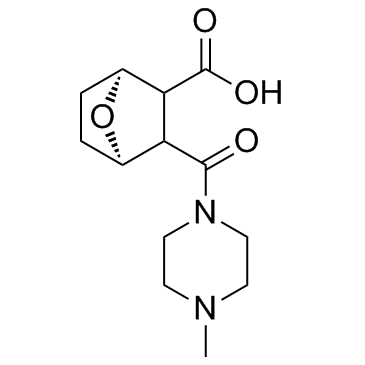1632032-53-1
| Name | (1R,4S)-3-[(4-Methyl-1-piperazinyl)carbonyl]-7-oxabicyclo[2.2.1]heptane-2-carboxylic acid |
|---|---|
| Synonyms |
7-Oxabicyclo[2.2.1]heptane-2-carboxylic acid, 3-[(4-methyl-1-piperazinyl)carbonyl]-, (1R,4S)-
(1R,4S)-3-[(4-Methyl-1-piperazinyl)carbonyl]-7-oxabicyclo[2.2.1]heptane-2-carboxylic acid LB-100 |
| Description | LB-100 is a protein phosphatase 2A (PP2A) inhibitor, with IC50 of 0.85 μM and 3.87 μM in BxPc-3 and Panc-1 cells. |
|---|---|
| Related Catalog | |
| Target |
IC50: 0.85 μM (PP2 in BxPc-3 cell), 3.87 μM (PP2 in Panc-1 cell) |
| In Vitro | LB-100 inhibits the cell growth with IC50 of 2.3 μM (in BxPc-3) or 1.7 μM (in Panc-1 cell). In BxPc-3, Panc-1, and SW1990 cells, LB-100 reduces the PP2A activity by 30-50%. LB-100 increases concentration of doxorubicin within cells (2.5 fold to control) and sensitizes tumor cells to the cytotoxicity of doxorubicin. LB-100 increaseds VEGF secretion, and thus enhances HIF-1α-VEGF mediated angiogenesis[1]. LB-100 alters VE-cadherin integrity between endothelial cells. Pretreatment of LB-100 results in a nearly 40% increase in dye passing through the HUVECs monolayer. LB-100 induces higher paracellular permeability of vascular endothelial cells potentially accounting for LB-100 increasing the concentration of doxorubicin in tumor cells[2]. LB-100 downregulates Bcl-2 expression and enhances sorafenib-induced apoptosis in HCC cells[3]. |
| In Vivo | LB-100 (2 mg/kg, i.p.) decreases in a time-dependent manner the activity of PP2A in xenografts and livers in nude mice. LB-100 does not alter the expression of the three PP2A subunits (PP2A_A, PP2A_B, and PP2A_C) in cell lines, xenografts, or livers, as confirmed by immunoblotting. The combination of doxorubicin (1.5 kg/mL, every other day) and LB-100 (2 mg/kg, every other day) significantly slows the growth of tumors with reduction of tumor volume in two animals with no effects on tumor growth in animals treated with single agents[2]. |
| Kinase Assay | Cultured pancreatic cancer cells are treated with IC50 of LB-100 for each cell line or equal volume of vehicle for 2 hours, and PP2A activity assays are then performed using Ser/Thr phosphatase assay kit. Cells are lysed with an ultrasonic cell disruptor, and the PP2A concentration is measured using a Ser/Thr phosphatase assay kit according to the instructions. Assays for each cell line are performed in triplicate. |
| Cell Assay | Cytotoxicity is conducted by using a Cell Counting Kit-8. Cells are seeded in 96-well plates with a density of 3000 cells per well and are assessed after treatments following the CCK-8 protocol. Relative cytotoxicity is expressed as a percentage of specific controls. |
| Animal Admin | BALB/c nude mice are injected subcutaneously in the right flank with 1×106 Huh-7 cells suspended in 200 μL PBS per mouse. After a tumor volume of 100 to 200 mm3 is reached, tumor-bearing mice are randomLy allocated to four groups: control group, doxorubicin/cisplatin group, LB-100 group, and doxorubicin/cisplatin plus LB-100 group. For the doxorubicin plus LB-100 study (n=6 to 8), doxorubicin and LB-100 are injected i.p. at 1.5 and 2 mg/kg, respectively, on alternate days for a total of 16 days. For the cisplatin plus LB-100 study (n=8 to 10), cisplatin and LB-100 are injected at 3 and 2.5 mg/kg, i.p., respectively; cisplatin is injected every 4 days and LB-100 is used every other day for 16 days. Control mice are injected with DMSO (in the doxorubicin plus LB-100 group) or PBS (in the cisplatin plus LB-100 group) on the same schedule as the drug-treated animals. Tumor size is monitored every 3 or 4 days, and is calculated by the formula: tumor volume=length × width × height/2. All mice are sacrificed at day 16, and xenografts are obtained, weighed, and fixed with 10% formaldehyde. |
| References |
| Density | 1.3±0.1 g/cm3 |
|---|---|
| Boiling Point | 486.9±45.0 °C at 760 mmHg |
| Molecular Formula | C13H20N2O4 |
| Molecular Weight | 268.309 |
| Flash Point | 248.3±28.7 °C |
| Exact Mass | 268.142303 |
| LogP | -0.56 |
| Vapour Pressure | 0.0±2.6 mmHg at 25°C |
| Index of Refraction | 1.562 |
| Storage condition | 2-8℃ |
